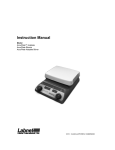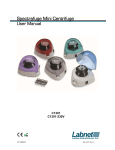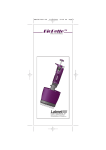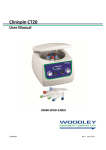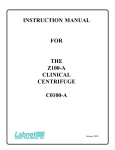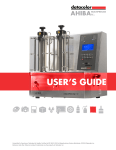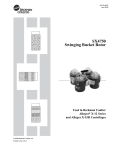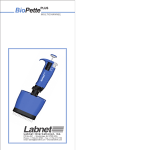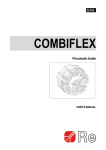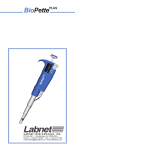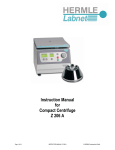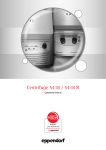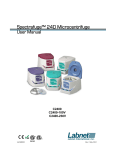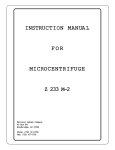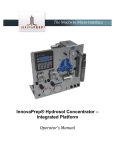Download Spectrafuge 7M Instruction Manual Book Form
Transcript
Instruction Manual Labnet Spectrafuge 7M Microcentrifuge Labnet International PO Box 841 Woodbridge, NJ 07095 Phone: 732 417-0700 Fax: 732 417-1750 email: [email protected] IMPORTANT NOTICE The use of IsoQuick® brand nucleic acid extraction kits with this product is not advised. If the IsoQuick® extraction matrix or dye components come in contact with the Ultem® rotor used in this product, they may cause cracks or striations. Cracked rotors may disrupt during use. If any IsoQuick® brand components come in contact with the rotor in this product, immediately replace the rotor. Please fully read the Rotor Care or Rotor Usage Guide section of this manual to learn more about rotor safety. Copyright August 2001, Labnet International. All rights reserved. Reproduction without prior written permission is prohibited. Information contained herein is subject to change without notice. Table of Contents Notes 1. General Information Description Safety precautions Technical data Accessories supplied with unit Warranty 1 2. Installation Unpacking the centrifuge Required space Installing the centrifuge 3 3. Installing the Rotor Rotor and accessories Mounting and securing the angle rotors Removing the rotor Overloading rotors 4 4. Operation Closing the lid Lid release Lid lock Speed selection Selection of operating time 7 5. Service and Maintenance Service Cleaning Rotor care Disinfection Replacing fuses 9 6. Troubleshooting 12 7. Where to Call 12 8. Determination of g-values 13 1. General Information This manual provides important safety information for the Spectrafuge 7M laboratory microcentrifuge. It should be kept near the centrifuge for quick and easy reference. 1.1 Description The Spectrafuge 7M is a small benchtop centrifuge designed for separation of various research samples. A 12 x 1.5ml rotor for micro samples is supplied with the unit. Adapters are available for tubes smaller than 1.5ml. The Spectrafuge 7M reaches speeds of up to 10,000rpm/7176 x g. 1.2 Safety precautions Note: All users of the centrifuge must read the Safety Precautions section of this manual before attempting to operate the unit! ! If this equipment is used in a manner not specified by the manufacturer, the protection provided by the equipment may be impaired. Thoroughly inspect the centrifuge, rotor and accessories for mechanical and chemical damage prior to each use. Mechanical damage can often be visually observed, and includes cracks, scratches or gouges on the centrifuge lid or rotor. Chemical damage can often be visually observed and includes crazing, peeling or similar deterioration of the inner cavity, lid, rotor or surfaces. (See section 5.3 for detailed instructions on inspecting the rotor.) The rotor cover provided is not intended to be a bioseal (as defined by IEC 21010-2-020) for containment of pathogenic microbiological specimens during use. While a small amount of vibration during rotor acceleration or deceleration is normal, immediately stop the centrifuge is excessive vibration is evident at any time. Do not operate the centrifuge if any of the following conditions exist: -The centrifuge has not been installed properly -The centrifuge is partially dismantled -Service has been attempted by unauthorized or unqualified 1 To use this chart, find the radius value on the radius scale. Place the edge of a ruler on the value. Place the right side edge of the ruler on the speed scale at the desired speed. The estimated RCF can then be read from the RCF scale where the ruler edge passes through it. This chart can also be used to determine the proper speed for the desired RCF value. 14 Should your Spectrafuge 7M require service, please call Labnet’s Technical Services Department at 732 417-0700. Our Service Department is staffed from 8:30am to 5:00pm, EST, Monday through Friday. Our 24 hour fax number is 732 417-1750. Electronic mail may be sent to [email protected] Please be sure to have the unit’s serial number (located on the back panel of the instrument) available when calling. Should an item require return to Labnet for service, a return authorization (RA) number must first be received from Labnet. Items sent without an RA number will not be accepted. 8. Determination of g-values The centrifuging radius of the 1.5ml rotor is 6.3cm. See the following page for the formula for determining g-values and a quick reference chart. personnel -The rotor has not been installed securely on the motor shaft -Rotors and accessories not belonging to the standard range are being used without permission being obtained from the manufacturer to use such rotors and/or accessories in the centrifuge Exception: Microcentrifuge tubes made of plastic, normally available in the laboratory. -The centrifuge is located in an explosive atmosphere -Materials to be centrifuged are combustible and/or explosive -Materials to be centrifuged are chemically reactive -The rotor load is not properly balanced -Damage to the rotor or centrifuge is evident -The rotor has been dropped or abused, even though damage cannot be observed 1.3 Technical data 13 Manufacturer Labnet International PO Box 841 Woodbridge, NJ 07095 Phone 732 417-0700 Fax 732 417-1750 Type Spectrafuge 7M Dimensions Width Depth Height 8.25 inches 8.9 inches 7.6 inches Maximum speed 10,000rpm Maximum RCF 7176 x g Maximum volume 12 x 1.5/2.0ml Admiss. density 1.2kg/dm3 Electrical/fuse rating 120VAC~, 50-60Hz, 0.5 amps/ 250V, 0.5AT 230V~, 50-60Hz, 0.25 amps/ 250V, 0.25AT 2 1.4 Accessories supplied with centrifuge Each unit is supplied with one 12 x 1.5ml rotor, instruction manual, rotor usage guide, warranty card and power cord. 1.5 Warranty Technical data section of this manual.) 6. Troubleshooting Guide Please refer to this guide before calling for service. Centrifuge will not start This centrifuge has been subject to thorough testing and quality control. In the unlikely event of a manufacturing fault, our one year warranty (from the date of delivery) covers the centrifuge and rotor. This warranty becomes invalid in the case of incorrect operation, use of nonstandard spare parts or accessories and unauthorized modification of the rotor or centrifuge. The rotor warranty does not cover normal wear and tear or damage or weakening caused by radioactive contamination or frequent autoclaving. Labnet reserves the right to make technical modifications. Statements contained herein are not to be considered binding. Possible reason: Solution: No power supply Check that power is being supplied to the outlet Check that the power cord is plugged into both the wall outlet and the back of the centrifuge Check that the power cord in intact and not damaged Possible reason: Solution: Blown fuse Check fuse and replace if necessary Lid lock will not release 2. Installation Possible reason: Solution: Defective lid lock Open manually and have unit serviced Before unpacking the centrifuge, inspect the outside of the carton for any shipping damage. Possible reason: Solution: No power from PC board Call for service The centrifuge is delivered in a carton with protective cushions. Remove the centrifuge from the carton. Retain the carton and cushions until it has been established that the centrifuge is working properly. Possible reason: Solution: Lid lock is jammed Call for service Possible reason: Solution: Centrifuge is not receiving power See “Centrifuge will not start” 2.1 Unpacking the centrifuge Inspect the centrifuge for any visible signs of shipping damage. Shipping damage is the responsibility of the transportation carrier. Any claims for damage must be filed within 10 days. The accessories and rotor usage guide supplied with the centrifuge should be kept with the instruction manual near the centrifuge’s place of installation. 2.2 Required space Centrifuge cannot be started, although power is on Possible reason: Solution Lid not closed correctly Close lid correctly Possible reason: Solution: No speed or time has been selected Set speed and/or time 7. Where to call The centrifuge should be installed on a rigid, even surface such as a stable laboratory bench, cabinet, etc. To guarantee sufficient ventilation, ensure that the centrifuge has at least 15cm (6 inches) of free space on all sides, including the rear. The centrifuge should not be located in areas subject to excessive heat such as in direct sunlight or near radiators or the 3 Should you have any questions about the Spectrafuge 7M or its accessories, please call Labnet’s Customer Service Department at 732 417-0700. Customer Service is staffed from 8:30am to 5:30pm, EST, Monday through Friday. Our 24 hour fax number is 732 4171750. Inquiries may also be sent via our electronic mailbox at [email protected]. 12 The rotor may be cleaned using methyl or isopropyl alcohol soap solutions, heptane, hexane, naptha or Freon TF cleaner. Do not use corrosive cleaning agents with partially halogenated hydrocarbons such as 1,1,1 trichloroethane, phenol, methylene chloride or ketones such as MEK. When necessary the rotor and rotor cover may be autoclaved at 115 kPa absolute pressure (121º to 124ºC). Note: autoclaving decreases the usable life of the rotor. If the rotor is autoclaved frequently (once a day) the rotor should be replaced every 3 months. If the rotor is autoclaved more than once a day, it should be replaced after 60 autoclaving cycles. All other rotors should be replaced on an annual basis. The rotor should mot be immersed in any solution below -10ºC (such as LN2 or LCO2). Handle the rotor carefully. It should not be tossed or dropped. Dropping can create small cracks that may or may not be visible to the eye. A crack in the rotor can result in a rotor disruption during a spin. Any rotor which has been subject to abuse, regardless of any evidence of physical damage should be discarded. Any rotor and/or rotor cover that becomes contaminated by radioactive samples should be discarded as the exposure may reduce the strength of the rotor material. 5.4 Disinfection Should a spill of infectious materials occur within the rotor or rotor chamber, the unit should be disinfected. This should be performed by qualified personnel with proper protective equipment. exhaust of a compressor, as a buildup of heat may occur within the chamber. 2.3 Installation Make certain that the timer is set to the off position. Before operating the centrifuge, check that the power supply corresponds to that on the manufacturer’s rating label, then connect the power cord to the centrifuge and the power supply. ATTENTION: The timer must be in the OFF position before connecting the power cord. Failing to place the timer in the off position may result in damage to the centrifuge and injury to personnel. 3. Installing the rotor 3.1 Rotor and accessories The following rotor and accessories are available for the Spectrafuge 7M: Angle rotor for 12 x 1.5ml tubes Order no. C-9312 (supplied with unit) Tube measurement 1.5ml (10 x 40mm) Max. speed 10,000rpm Centrifuging radius 6.3cm RCF (g-value) 7176 x g Replacement rotor cover, pack of 2 Order no. C-9312-RC Adapter for 0.5ml tubes Order no. Tube measurement Max. speed C-1205 8 x 30mm 10,000rpm Adapter for 0.4ml tubes Order no. Tube measurement Max. speed C-1206 6 x 47mm 10,000rpm Adapter for 0.2ml tubes Order no. Tube measurement Max. speed C-1222 6 x 21mm 10,000rpm 5.5 Replacing fuses Check the fuse when it is recommended in the Troubleshooting Guide located in this manual. The fuse holder is located in the power inlet on the rear of the unit. Disconnect the power cord from the power inlet. Open the fuse holder drawer by inserting a small screwdriver under the tab and prying it open. Remove the innermost (operative) fuse from its retaining tabs and replace the fuse if necessary. A spare fuse is located in the outermost chamber of the fuse drawer. Replace only with a fuse of exactly the same value as the original. (Fuse type may be found in the 11 4 Figure 1. Installing the rotor cover. Figure 4. Checking the rotor hub. Figure 2. Unbalanced rotor load. Figure 5. Checking the rotor web area Figure 3. Balanced rotor load. 5 Figure 6. Checking the outer rim of the rotor. 10 5. Service and Maintenance 3.2 Mounting and securing the angle rotor 5.1 Centrifuge service The motor in the Spectrafuge 7M requires no routine maintenance. Any required service should be performed by authorized, qualified personnel only. Repairs performed by unauthorized personnel may void the warranty. 5.2 Cleaning the centrifuge Always keep the centrifuge housing, rotor chamber, rotor and rotor accessories clean. All parts should be wiped down periodically with a soft cloth. For more thorough cleaning, use a neutral cleaning agent (pH between 6 and 8) applied with a soft cloth. Excessive amounts of liquid should be avoided. Liquid should not come into contact with the motor. After cleaning, ensure that all parts are dried thoroughly by hand or in a warm air cabinet (maximum temperature 50ºC) 5.3 Rotor care The rotor should be inspected before each use for mechanical or chemical damage. The inspection should focus on the following areas: • The underside of the rotor, including the area around the hub. (See figure 4.) • The web area between the sample tube slots. (See figure 5.) • The outer rim of the rotor. The rotor is comprised of two pieces which have been ultrasonically welded together; any movement felt between the bottom and top pieces indicates that a weld has been broken, rendering the rotor unsafe. (See figure 6.) - Mechanical damage can often be visually observed and includes cracks, scratches or gouges. - Hidden mechanical damage may be detected by an increase in noise or vibration during a spin. Again check the rim for looseness. (See figure 6.) - Chemical damage appears as discoloration, crazing, granulation, peeling or similar deterioration of the finish. If any of the above are noted, discontinue use immediately! 9 The rotor supplied with the Spectrafuge 7M has been precision balanced for optimum performance and quiet operation at maximum speed. To minimize vibration and maintain quiet operation, the rotor should be installed with the arrow mark on the bottom of the rotor aligned with the mark on the rotor snap. With the markings on the rotor and snap aligned, center the rotor over the hub and push down slightly, keeping the rotor flat and evenly spaced within the centrifuge chamber. Push the rotor down until it locks into position. When loading the rotor, refer to figure 3 (located on the opposite page). Loading in the pattern indicated will ensure a balanced load. Tubes to be loaded should be filled equally by eye. The difference in the weight between the tubes should not exceed 0.1 gram. A partially loaded rotor may be centrifuged if the loading scheme for balancing a rotor given in figure 3 is followed. Never spin samples which are flammable, explosive or which chemically interact vigorously when mixed. Discard any rotor or rotor cover that becomes contaminated by radioactive samples, as the exposure may reduce the strength of the rotor material. Always use the rotor cover. The rotor cover is designed to minimize wind resistance on the spinning rotor, enabling it to achieve speed more quickly. Spinning without the rotor cover in place may result in motor failure. Although the rotor cover is not intended to be a bioseal, it does provide an extra layer of protection against contamination in the event of tube breakage. 3.3 Removing the rotor The rotor is removed simply by grasping the sides and pulling up firmly. Be sure to lift upward in a straight, vertical motion. 3.4 Overloading rotors The maximum load of the rotor and the maximum speed have been established by the manufacturer. Do not attempt to exceed these values. The maximum speed of the rotor has been measured for liquids having a homogeneous density of 1.2g/ml or less. In order to centrifuge liquids with a higher density it is necessary to reduce the speed. Failure to reduce the speed may result in damage to the rotor and centrifuge. The 6 revised maximum speed can be calculated with the following formula: Reduced speed (nred) = Example: 1.2 higher density value x max speed (nmax) Where the density of the liquid is 1.7, the new maximum speed would be calculated as follows: nred = 1.2 1.7 x 10,000 = 7058 rpm If in doubt concerning maximum speeds, please contact the manufacturer for assistance. 4. Operation ATTENTION: Never attempt to operate the centrifuge with rotors or adapters that show signs of corrosion or mechanical damage. Never centrifuge strongly corrosive materials that may damage the rotors or accessories. WARNING: Do not attempt to open the lid of any centrifuge until the rotor has come to a complete stop. In the event of a power failure or malfunction, it may be necessary to open the lid manually. 1. Disconnect the power cord from the wall socket. 2. Remove the plastic plug, located on the left side panel of the unit, near the front. 3. Pull the cord (attached to the plug) to open the lid lock manually. 4.3 Lid lock The centrifuge can be started only with the lid securely closed. When the rotor begins to accelerate, the lid button becomes inoperable. Do not attempt to open the lid until the lid lock indicator turns off. 4.4 Speed selection The speed (rpm) can be selected to 10,000rpm with the knob labeled speed. The scale is directly proportional to the speed - a setting of 5 corresponds to 5000rpm, a setting of 9 corresponds to a speed of 9000rpm, etc. 4.5 Selection of operating time Operation of the centrifuge begins when the timer knob is turned clockwise to set a run time. For run times less than 5 minutes, turn the knob clockwise past the halfway point and then counterclockwise to the desired time. For run times longer than 5 minutes, turn the knob clockwise to the desired time. Figure 4. Spectrafuge 7M control panel layout When the preselected time expires, the centrifuge will stop automatically. To stop the centrifuge prior to the expiration of set time, turn the timer knob to the zero position. 4.1 Closing the lid After the rotor has been properly secured and loaded, close the centrifuge lid, making sure that the interlock has been engaged. 4.2 Lid release The lid button, located on the front panel above the speed control, must be pressed to open the lid after a centrifuge run has been completed. Note that the lid button will not operate until the rotor has come to a full stop. 7 Some models are equipped with a timer that includes a hold position. Continuous operation of these models may be achieved by turning the timer knob firmly to the left. The centrifuge will continue to operate until the knob is turned to the zero position. Note: The timer knob may be turned in either direction during operation of the centrifuge without damage to the timer mechanism. 8












